 |
 |
Production of Sharp’s AQUOS LCD color TVs passed the five-million mark*1 on December 28, 2004. Sharp has also been providing larger screen LCD TVs and higher performance models with a variety of lineup as well as delivering new viewing styles for LCD TVs. |
| |
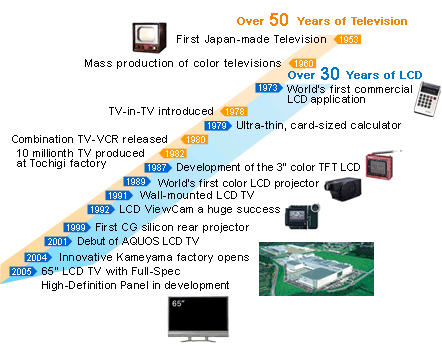
|
 |
 |
| |
Sharp was the first to bring electronic calculators incorporating ICs or LSIs to the market but further miniaturization would only be possible if the display could be made smaller. The fluorescent elements, or LEDs (light emitting diodes), used in displays up to that time consumed a lot of electricity, so calculators had to be equipped with bulky batteries. Sharp set out to find a new display that would use less energy and take up less space. After examining the problem from every angle, it was finally decided to begin research into LCD (liquid crystal display) technology in 1970.
|
 |
 |
| |
Though the superior characteristics of LCDs had already been recognized by researchers throughout the world, the technology was generally dismissed as impractical for commercial use due to the difficulty of selecting and combining the necessary materials. But through the unrelenting efforts of Sharp's engineers, the company succeeded in 1973 in introducing a calculator with the world's first practical LCD unit. This second electronic calculator was truly a breakthrough and became a big hit. Compared to the first calculator, it was only 1/12 the depth, 1/125 the weight, consumed only 1/9000 the power, and could be used 100 hours on one D3 battery.
|
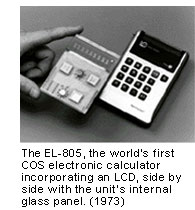 |
 |
 |
| |
One Sharp success in optoelectronics was the development in 1988 of the world's first 14-inch color TFT LCD. A mere 2.7 cm thick, it boasted a sharp, bright picture. This development showed that the long-awaited, wall-mount LCD TV and truly portable data communications terminals were on the horizon.
|
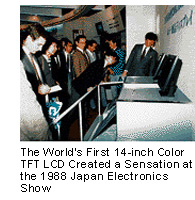
|
 |
 |
| |
In October 1992, the debut of the LCD ViewCam introduced a whole new concept in video cameras. Its ease of use gave Sharp an immediate share increase in the video camera market. The ViewCam was chosen as one of just 16 products from among approximately 13,000 nominated for Nikkei Product and Service Excellence Awards. It was also chosen for the Nikkan Kogyo Shimbun's (Japan's leading industrial daily) 10 Best New Products Awards. The LCD ViewCam became the flagship product that showed the world that "LCD is Sharp" and contributed to boosting the company image.
|
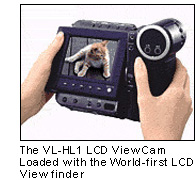 |
 |
 |
| |
Sharp created a buzz with the announcement of a 28-inch TFT LCD using next-generation LCD technology. The announcement boosted demand enthusiasm for LCDs for computers and large-screen wall-mount TVs in a new age of multimedia.
|

|
 |
 |
| |
Using the new CG-Silicon (continuous grain silicon) technology jointly developed with Semiconductor Energy Laboratory Co., Ltd. (Atsugi, Kanagawa Prefecture), Sharp made a splash with its prototype ultra high-definition 60-inch rear projector that uses three 2.6-inch CG-Silicon LCD panels.
The technology gained much attention for its ability to produce breathtaking ultra high-definition large-screen images and was regarded as pioneering a new age of digital audio-visual enjoyment.
|
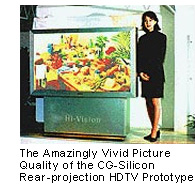 |
 |
 |
| |
Sharp introduced the AQUOS LCD color TV (LC-20C1/15C1/13C1), the ideal TV for the household of the digital 21st century.
Sharp went on to offer consumers more ways to enhance their lifestyles with more AQUOS product introductions: a PC card slot-equipped AQUOS (LC-20B1/15B1/13B1), a wide 30-inch digital HDTV model (LC-30BV3) that can be a family's main TV, and the AQUOS Theater, a stylish entertainment system that's a combination of AQUOS and a DVD 1-bit digital theater system.
|
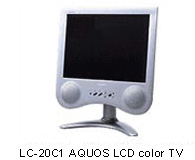
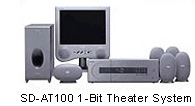
|
 |
 |
| |
The most advanced facility for the integrated production of LCD TVs from the manufacturing of LCD panels to assembly of final products is completed in Kameyama, Mie Perfecture, Japan, and started operation. The plant also provides the rationalization of the process of production, inspection and delivery, as well as technology development, resulting in high production efficiency and high value-added performance.
|
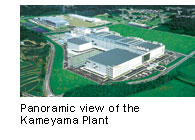 |
 |
 |
| |
Sharp Corporation has successfully developed a wide 65-inch AQUOS LCD color TV, the industry’s first and world’s largest*1.
The limit of LCD TV screen size was considered 45”, but size has been dramatically increasing, showing that LCD technology will continue advancing.
|

|
